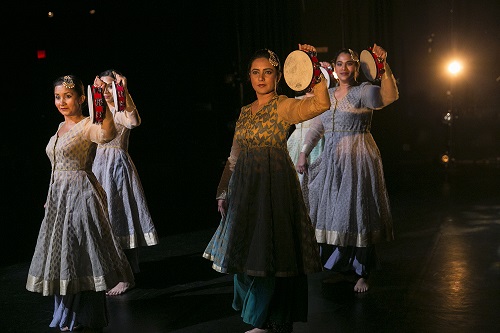In the context of the United States, Kathak dance, a classical North Indian dance tradition, occupies a marginal space within a larger landscape of dance cultures. That is why an event such as New York Kathak Festival has generated much excitement among patrons of Kathak dance. The New York Kathak Festival will be held from April 19th to April 21st, and Professor Pallabi Chakravorty will be bringing her company, Courtyard Dancers, as well as some Swarthmore students to the festival.
The New York Kathak Festival is a newly formed organization that aims to bring together the American Kathak community together for a dynamic and diverse exchange of movements and ideas. “It is the first time that such an inclusive festival is happening in America, although this is not the first Kathak festival happening in this country, since there have been other big Kathak festivals,” Professor Chakravorty said. “But it shows that Kathak is really growing in the diaspora as a dance form among various communities, so you could see that it is very vibrant and something that people want to be part of.”
The organizing of New York Kathak Festival defies the traditionally conceptualized model of cultural sharing; that is, the idea that culture is passed down from the older generation to the younger generation. This time, the younger generation is spearheading the movement to promote Kathak to a wider audience at the cultural center of the United States. “These are young Indian Americans who want to see their culture in this particular landscape of America,” Professor Chakravorty said. “They wanted to include various different choreographers coming from various different traditions within Kathak.”
Being that this festival brings together a diverse group of Kathak practitioners, Professor Chakravorty saw this as a good opportunity to expose Swarthmore students to the Kathak community that spans from the local to the global. “The students will be exposed to an international community of professional Kathak performers and choreographers, so this will be like a cultural immersion, even though the duration will be short,” Professor Chakravorty said. “They will see how India’s diversity of religion, language and costumes are expressed through movement, gestures and sound. Altogether, I am hoping it will be a transformative experience.” All students from the Kathak technique class were invited to attend this festival, and those who signed up will be making the trip soon.
Kathak dance belongs to the North Indian music and dance culture and it is both an Islamic form as well as a Hindu form. “It is a very syncretic dance form, and the dance form itself has a lot of diversity woven into it in terms of identity and aesthetics,” Professor Chakravorty said. In general, Kathak dance is high-energy, featuring a lot of turns and a lot of footwork. Rhythmically, the dance comes from percussion tradition, giving the form that high-energy. Yet, it is the more subtle aspects that Professor Chakravorty is currently interested in exploring: “All of these aspects are exciting, but I have always been interested in the more subtle aspects of Kathak like the subtle breath that goes into the movement, or the subtle hand gesture, or the expressive aspects of the face and how that integrates with a tilt of the torso. These are very fine-tuned things that the dance has so the dance is so strong yet so delicate.”
Courtyard Dancers will perform at New York Kathak Festival on its opening day, April 19th. The company functions as a performing group and as a school to train people in Kathak, with Professor Chakravorty as the company’s Founder and Artistic Director. The company seeks to find the relationship between movement and sound, as well as to create choreographies that explore social issues such as violence between Hindus and Muslims in India, Partition, and the delegitimization of courtesans as dancers to name a few topics. “We are really trying to figure out how to tell stories of modern times using the idiom of tradition since the dance traditionally tells mythological stories or various kinds of spiritual stories,” Professor Chakravorty said.
At the festival, Courtyard Dancers will be performing a piece that they have already showcased elsewhere, called Find Metiabruz. The title of the choreography references a place in Kolkata as well as a glorious history lost by the violent processes of colonialism. “It is a historic place which has completely lost its identity, and through this performance, we try to invoke that particular history so people can know a little bit,” Professor Chakravorty said. “This history relates to the Muslim aspects of Kathak dance, which has been under attack because of Hindu fundamentalism going on in India right now.” Find Metiabruz is accompanied by recorded music, tambourines, and recitations from the dancers.
As of now, the members of Courtyard Dancers are rehearsing as much as they can, since every member has a busy work schedule. They are engineers, doctors, lawyers, bankers, teachers, and students outside of the company, but because each of them want to see the uplifting of Kathak within America’s cultural landscape, they volunteer with much passion. Professor Chakravorty concludes, “The dedication I have from them is stupendous, and we work with very little resources, without grants, or without space. This is truly a labor of love.”
David Chan ’19
Photo by Sasha Fornari
